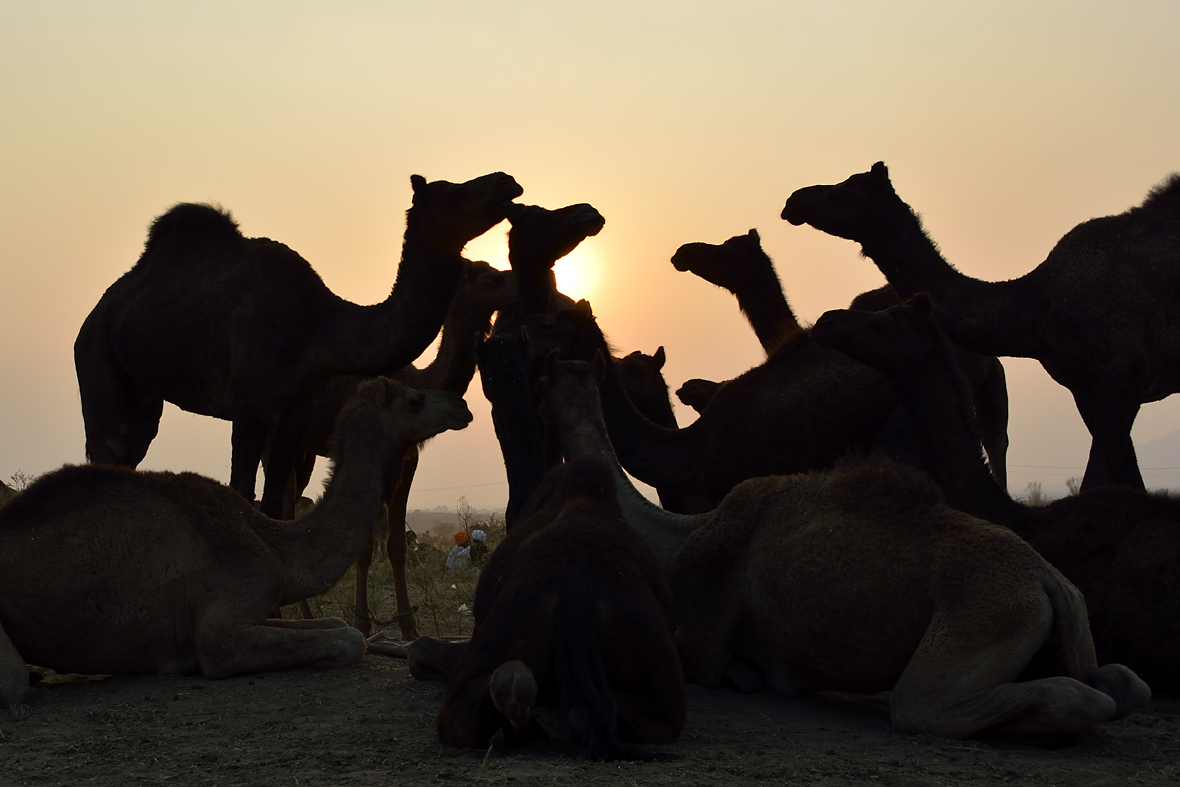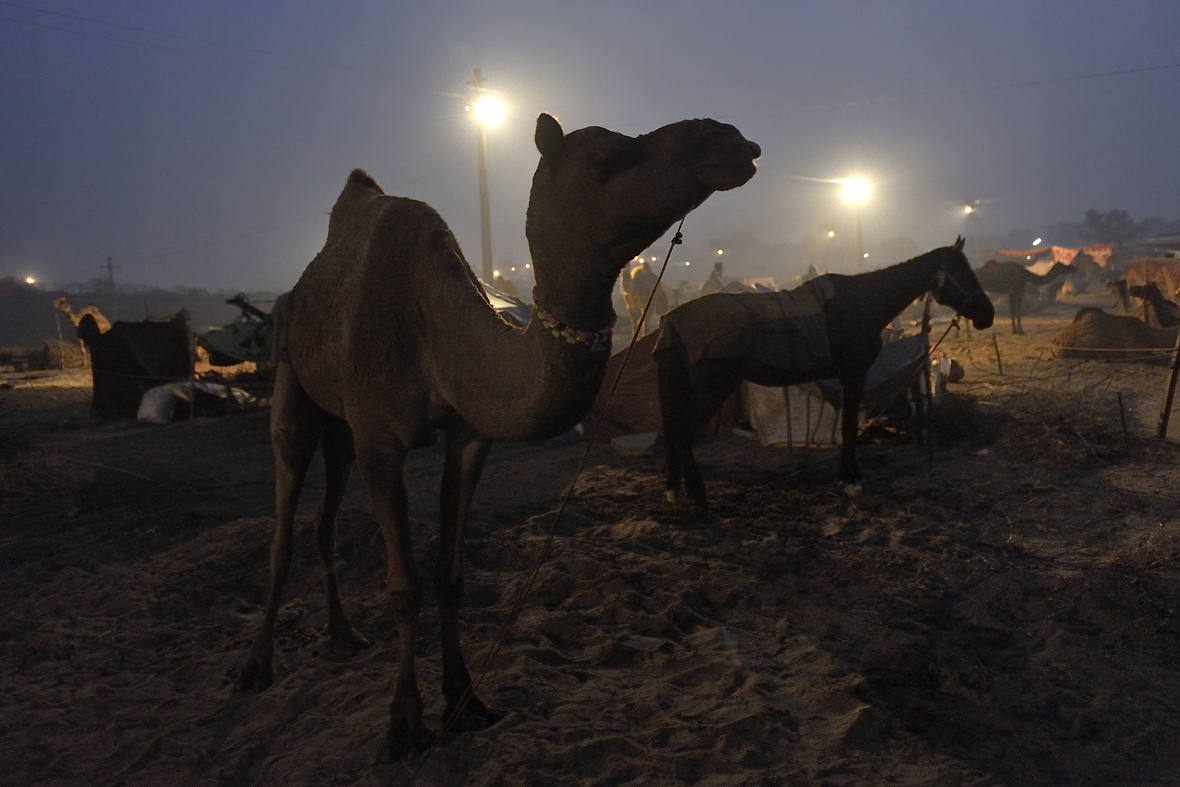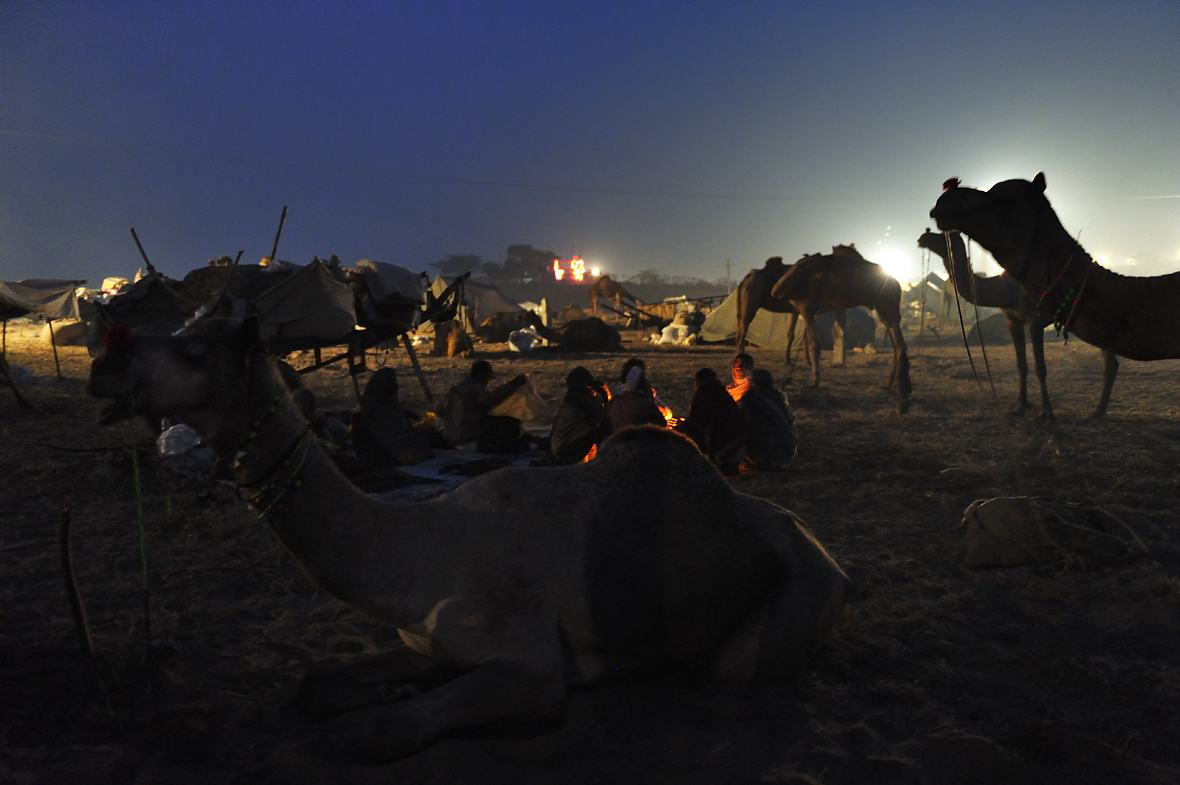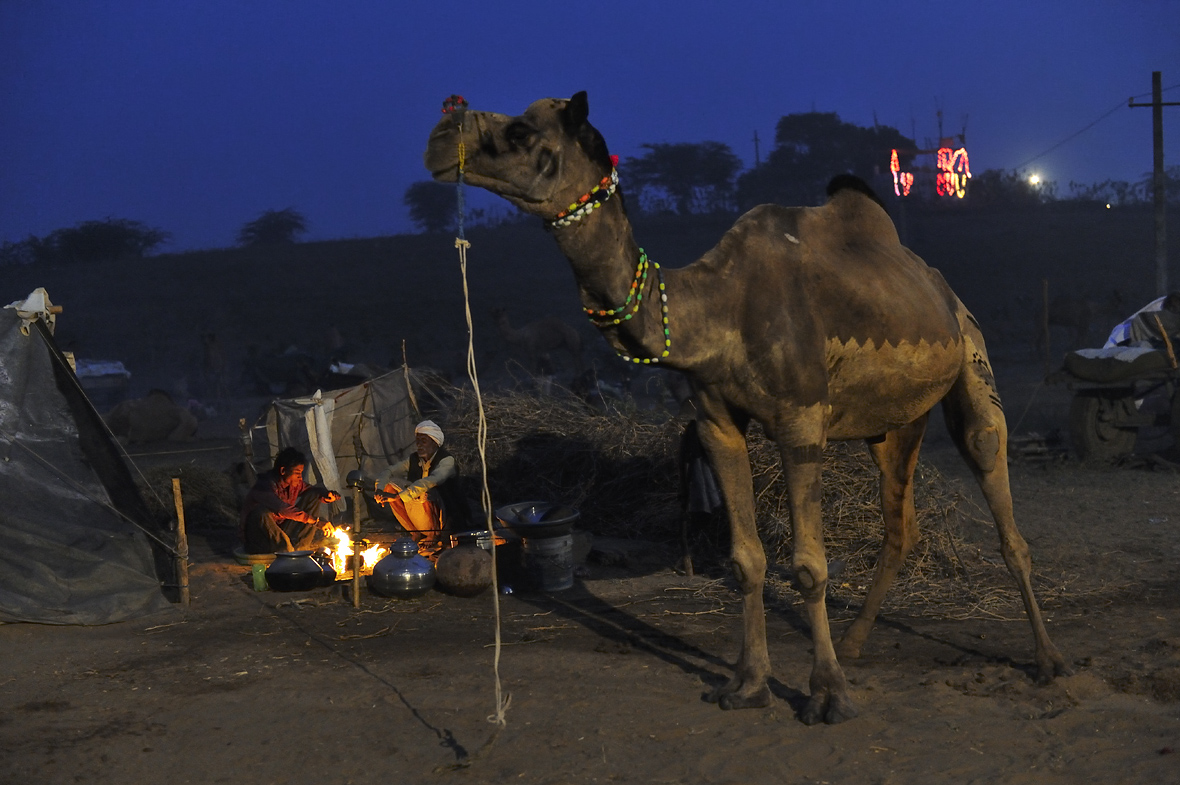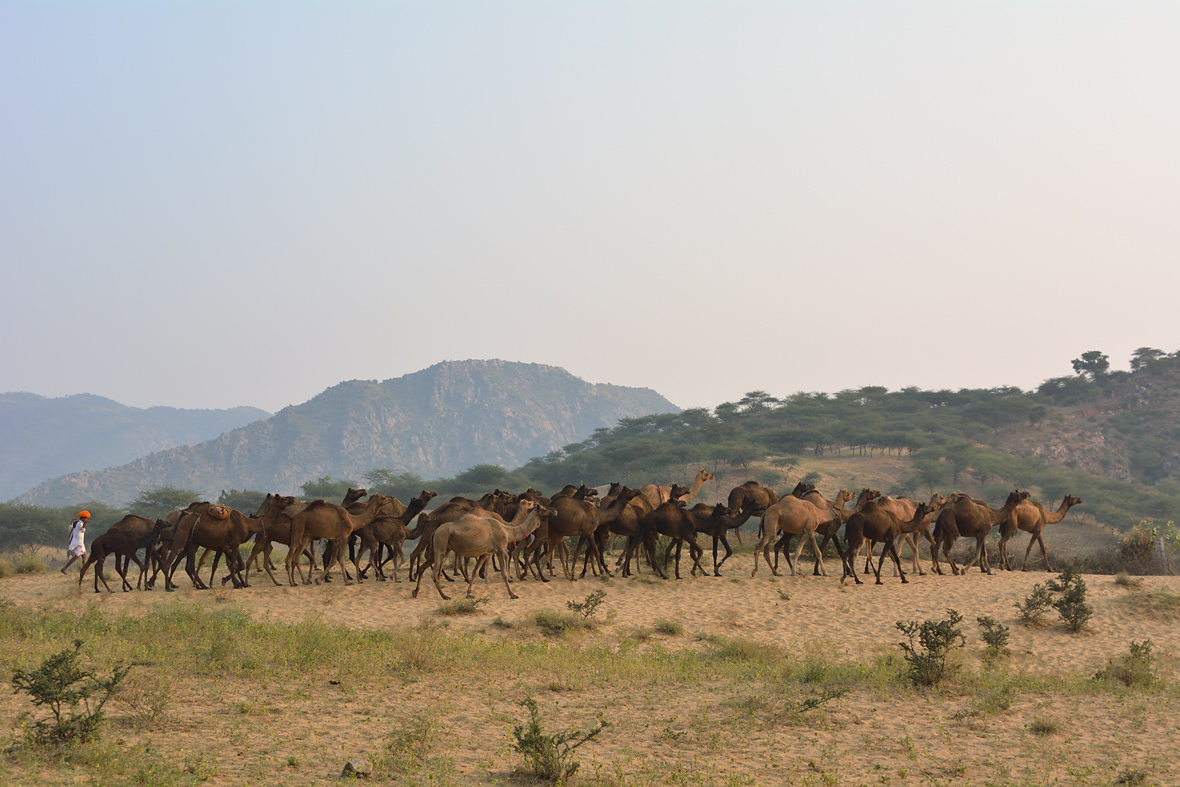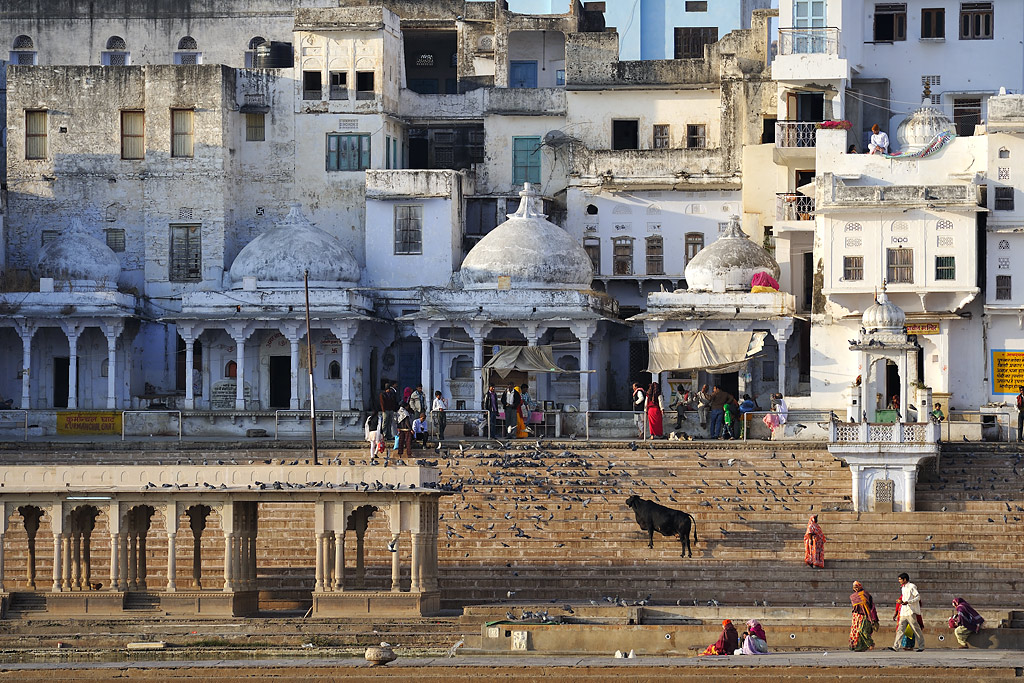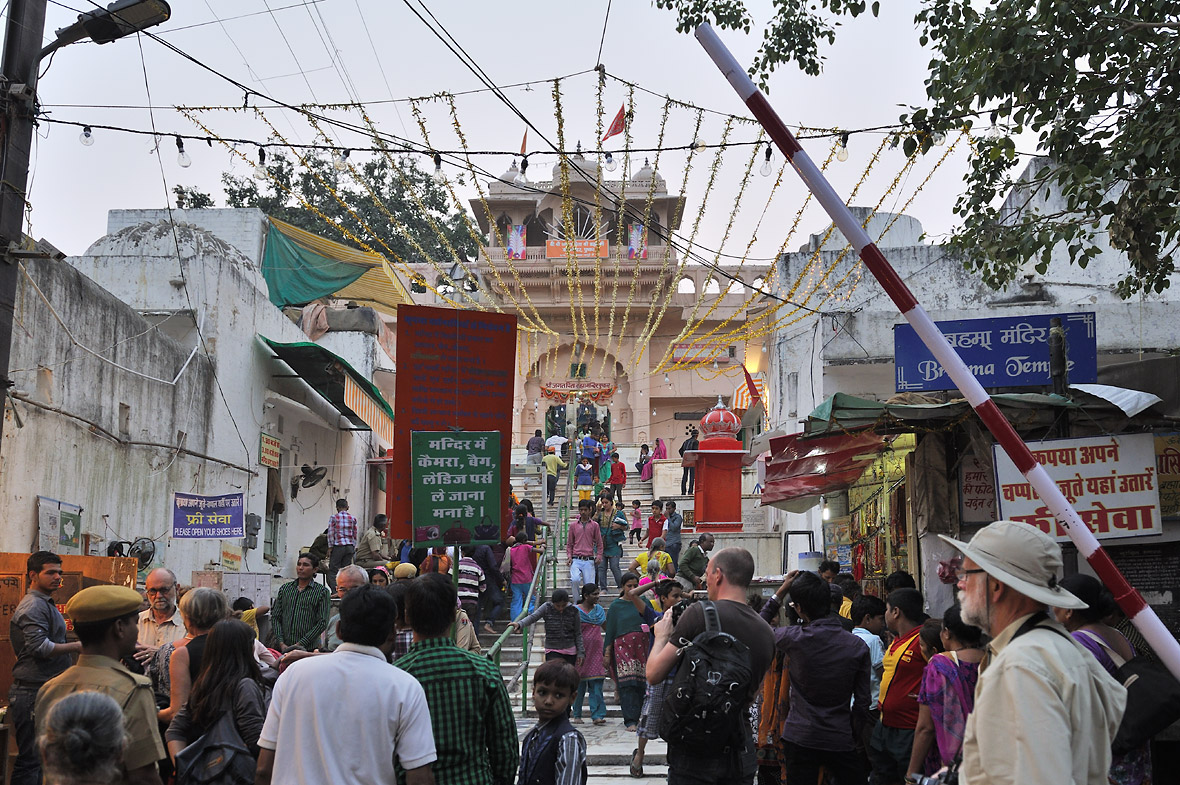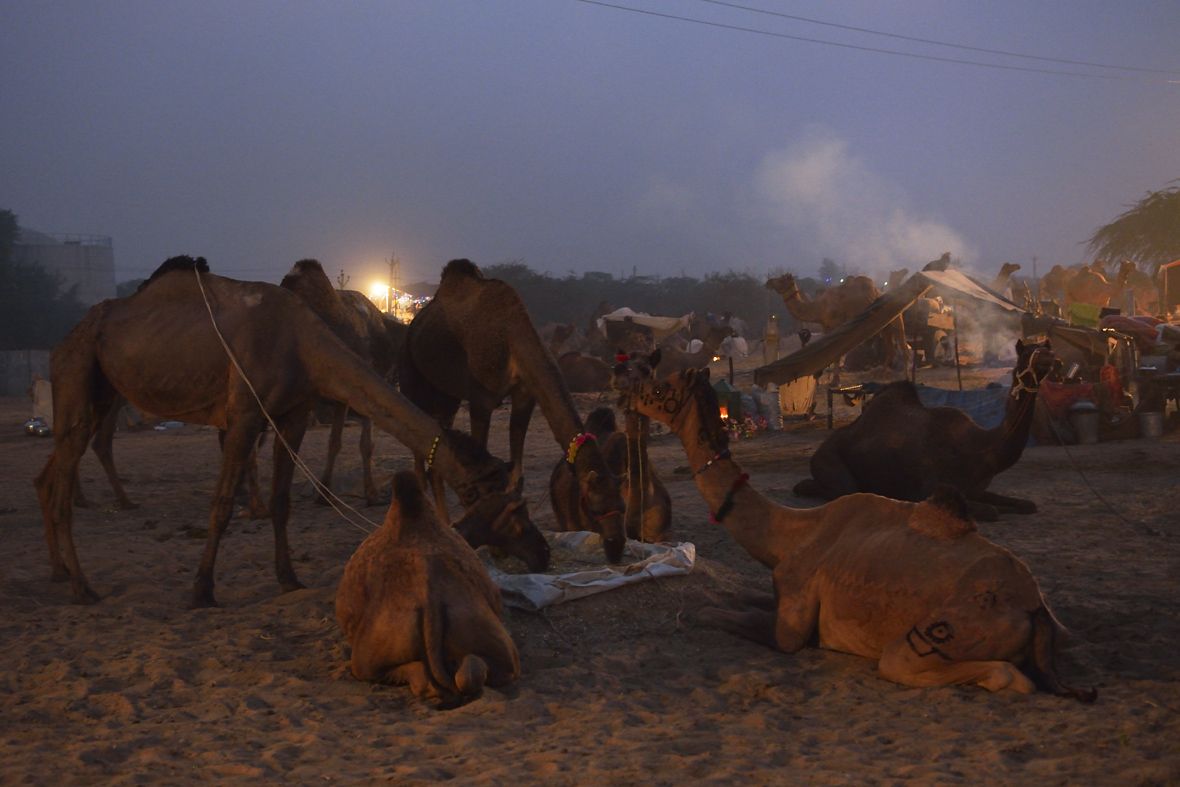|
|
In
the dark I can hear noises coming from afar, especially the low,
rumbling growls emitted intermittently by the camels, though the sounds
are somewhat muffled because of the distance. The tension mounts, as I
walk, hours before sunrise, the long 1.5 kilometer stretch towards the
largest camel fair in the world. Eventually I am able to discern the
still-faint outlines of the first tents and camels; a barely-there
fence lets me enter directly into the camel camp from the
dirt road.
|
|
|
|
The first photo
|
In the
distance a few night lamps illuminate the night, but here at the edge
of the camp, it is still pitchdark. Fortunately I had packed in a small
travel flashlight, because who wants to stumble over a sleeping camel?
Still, I feel very strange, somehow out of place, I know neither the
surroundings, nor do I, as a city rat, have the slightest idea about
camels! Do they bite? Or do they snap at you or perhaps they kick out,
like horses? So I better just walk around the animals once keeping a
safe distance.
It is 5.30 am and most of the campers are still sleeping, but one or
the other is already clanging his metal pans, fetching water at the
fountain, emerging from the bushes and a campfire is already burning.
Suddenly I am standing before my first camel! So I get my Nikon out of
my bag, turn up the ISO speed, and simply take a first test photo
– after all, it was specially for the camel fair that I had
undertaken the long journey all this way. The battery is full, the
memory cards newly formatted – let's get started! |
|
The
first campfire is already lit
|
|
|
|
The Pushkar Festival is
actually a combination of two seemingly completely different events. It
begins with the Pushkar Camel Fair (or Pushkar Mela), the
largest camel market in the world, the actual purpose of my trip, and
then merges into the Pushkar
Puja, one of the most religious celebrations, in honor of
the Hindu god Brahma, the Lord of creation.
In November each year, Pushkar, the otherwise sleepy nest of 20,000
inhabitants in the north-Indian state of Rajasthan comes to life, and
then during the camel fair and the Pushkar Puja, or the "Festival of Kartik Purnima",
it is practically bursting from the seams. Kartika Purnima is a sacred
festival for Hindus, Jains and Sikhs, which takes place at full moon (=
Purnima)
in the month October or November (= Kartika),
depending on the moon's position. Pushkar's hotel capacity falls short
many times over and to accomodate the many pilgrims and visitors, large
tents in all possible standards, from luxury camps with warm, running
water to plank-bed collective tents with common toilets, are set up
around the city. |
|
Onwards to Pushkar Mela! |
Pushkar
is regarded as one of the oldest Indian cities ever and since time
immemorial, it has attracted people from all over to its festival
– this makes the Pushkar festival one of the oldest
"continuous gatherings" in the history
of mankind – wow! The existence of the city
– and the festival – find mention in two of the
oldest Hindu epics, the "Ramayana"
and "Mahabharata"
dating from the 4th Century BC.
The mythology of the
Hindu
creator-god Brahma describes the origin of Pushkar Lake: As a demon
killed Brahma's children, he struck him with his weapon, the lotus
flower. The lotus leaves fell on three different parts of the world.
One of them was Pushkar, where, at this point, arose a lake. Brahma is
said to have then offered a sacrifice on this lake, under a full moon
in the month of Kartik,
to
bless the place. So in return, the city of Pushkar dedicated "their"
god Brahma, a great temple, the only one of its kind in the world.
Since then, a dip in the Pushkar Lake and a prayer in this temple
ensures redemption for the faithful.
|
|
|
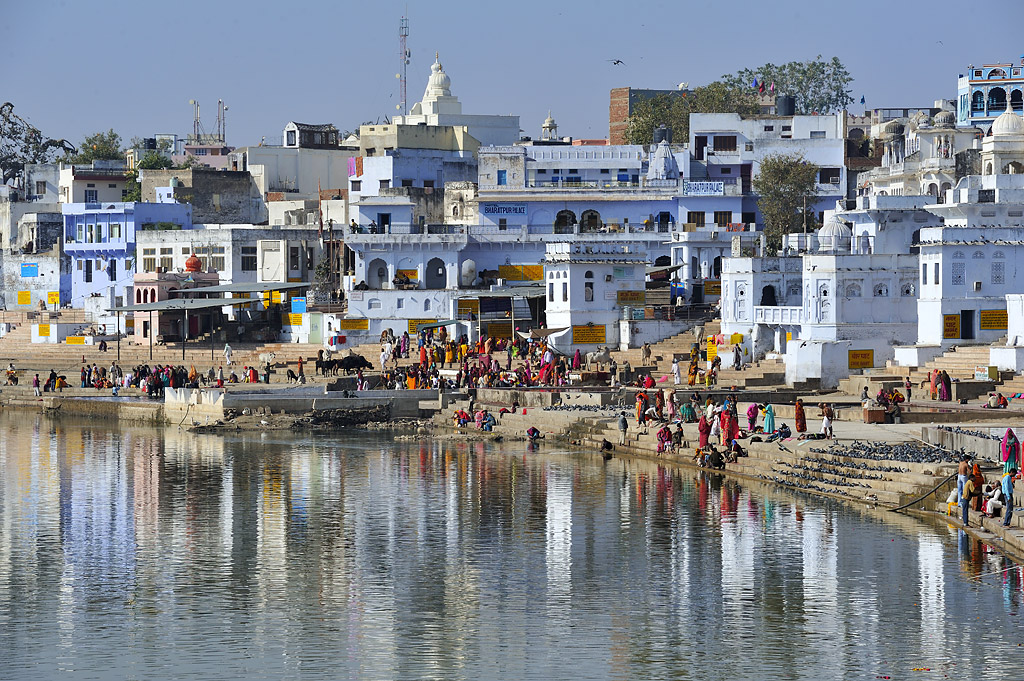
Pushkar Lake
|
“Calm before the
storm”: Ghat at the Pushkar Lake
|
India's only
Brahma temple from the 14th century
|
|
|
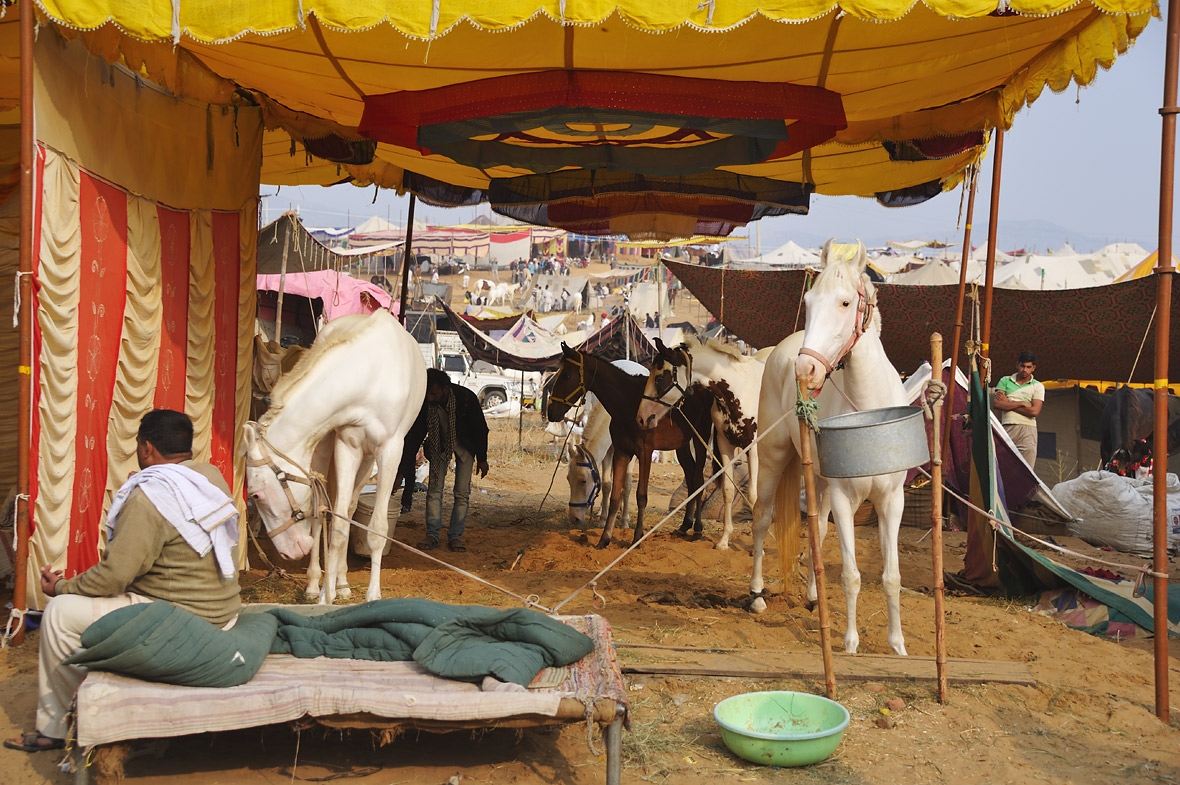
Horse trader at the Pushkar Mela
|
During
the camel fair “Pushkar Mela”, hundreds
of dealers
and breeders gather on a huge, sandy and slightly hilly area on the
outskirts of the city, and sell mostly camels, but also horses, bulls
and cows - originally the fair started out as a common cattle market.
In the course of time, however, the category "camels" assumed massive
proportions. Over 20,000 camels, some even say 50,000 but that seems to
me to be really exaggerated, from far and wide are brought and sold
there.
Through these two almost, simultaneously-occuring events, faith and
commerce intermingle in Pushkar to form an inseparable whole; and what
is, for Europeans, a contradiction, more likely represents the spirit
of India on a small scale – a good opportunity, therefore, to
get
a glimpse into the country, as the small town of Pushkar transforms
into a large, motley festival with the most colorful scenes and sounds. |
|
|
|
In
the meantime, the camp is fully awake, the warming campfires are
burning, animals and people are having their breakfast, the tea is
boiling. Since camel dung is normally used for the campfires
–
firewood being unaffordable for most – a slightly acrid smoke
with a very distinct smell, wafts in the mornings and the evenings
through the air.
|
I
see a few Asian tourists running around in a protective face-mask, as
if in an operating room, but that is just plain uncool and seems a bit
overdone to me. The bare, stripped-down, primitive ambience is
impressive, almost overwhelming, but also very authentic, it has simply
remained unchanged for a very long time. Almost everything takes place
on the floor and there is – at least in this part of the camp
– hardly any evidence of the modern, electrified and
plasticized
world, with the exception of the ubiquitous mobile phones, of course.
The smell is not unlike that of a huge cowshed, and you feel as if you
are traveling through time. I feel a little like a character in the
novel "The Time Machine" by H.G. Wells, except that in this case, it is
a journey to the past. I marvel at the goings-on, the people, and how
they have set it all up: wrapped up in blankets – the nights
are
cool, the days are warm to very hot, after all, we are here at the edge
of the Thar Desert, also known as the "Great Indian Desert" –
they sit around the campfire, the water brought to boil in charming
metal pitchers, the tents are basic, some sleep directly under the open
sky.
|
|
Breakfast in the Camel Camp
|
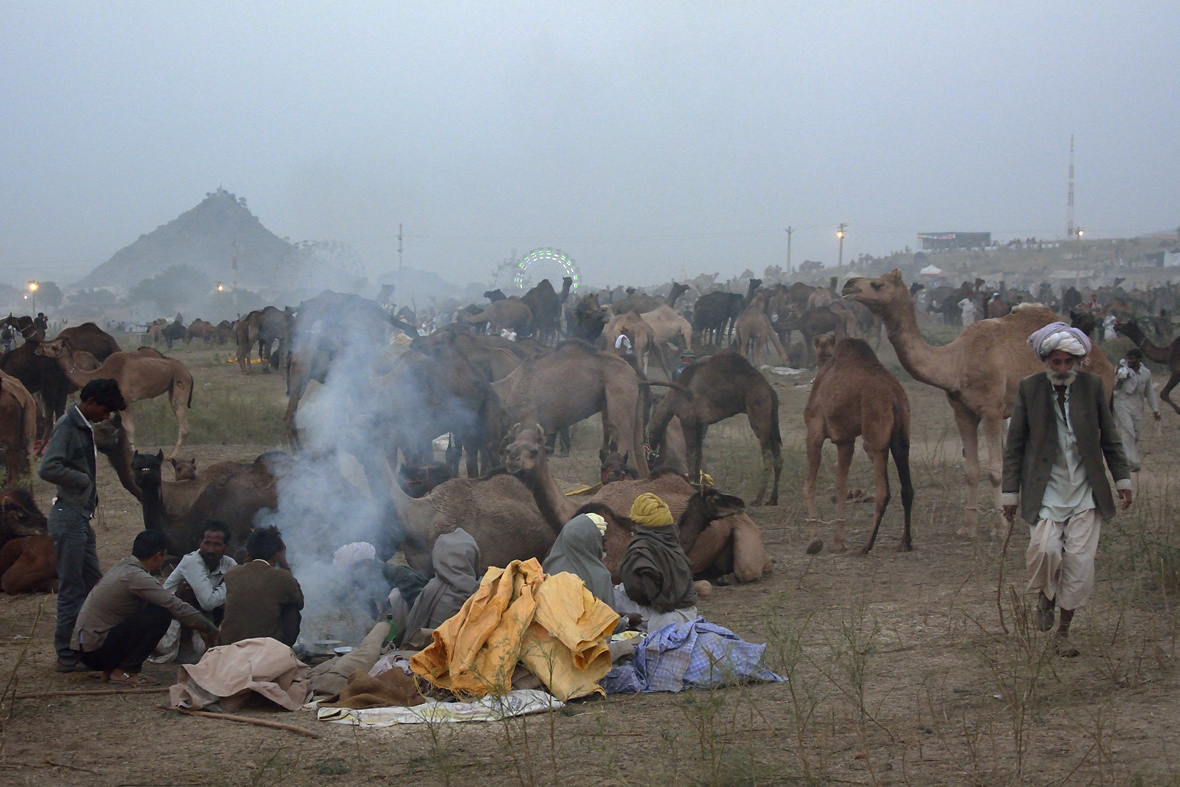
The nights are cold at the edge
of the "Great Indian Thar Desert"
|
|
Right at the beginning of my
tour, at the edge of the camp, I am greeted with a friendly “Which yourr cantrrie?”
from the son of a hawker peddling plastic jewelry, frippery, trinkets
and other such bric-a-brac. “Germany”. "Ohhh, veerry nice cantrrie, soo
nice, soo bjutiful!". "Thank you" (~ ‘How would
you know that?’). "Please
come, visit my father shop, I will show you evrryting! No need buy,
only luking ...!" He runs alongside me and is rather
tenacious.
As
there is no way he is going to accept a clear-and-simple no –
on
the contrary, it would only appear to him as one of my wily
negotiation tactics, and spur on his seller's pride – I
attempt a
friendly “Maybe later, OK?”. That works instantly,
he
hesitates briefly and goes: “OK, you prromised
me!”.
“No, wise-guy, I only said ‘may
be’”. “OK
OK, may be latrr”. He stops and smiles.
The hope of making a small sale must be allowed to survive,
always!
|
|
|
|
Everywhere
the camels are munching hay, that was either brought along or can be
purchased locally in desired quantities; some animals stand while
chewing, but many prefer to lie down and eat comfortably; and thus
slowly begins the first working day of the camel breeders and dealers.
It consists mainly of one thing: waiting. And so they sit there on
their own or in a group, between their camels, waiting for potential
buyers, chit-chatting endlessly, drinking the obligatory tea (chai) and
for a small fee, made clear by multiple internationally understood hand
gestures, they also like to be photographed.
Even before the fair begins, all camels are washed and decorated with
great care, many are sheared or painted in interesting patterns;
specialized stalls offer camel jewelry in all sizes, colours and
variations, from woollen bands, small mirrors, plastic bric-a-bracs to
ornaments of silver and pearls, as well as silver bells and anklets for
the fetters, which are very popular because they tinkle so beautifully,
when the camels run. |
|
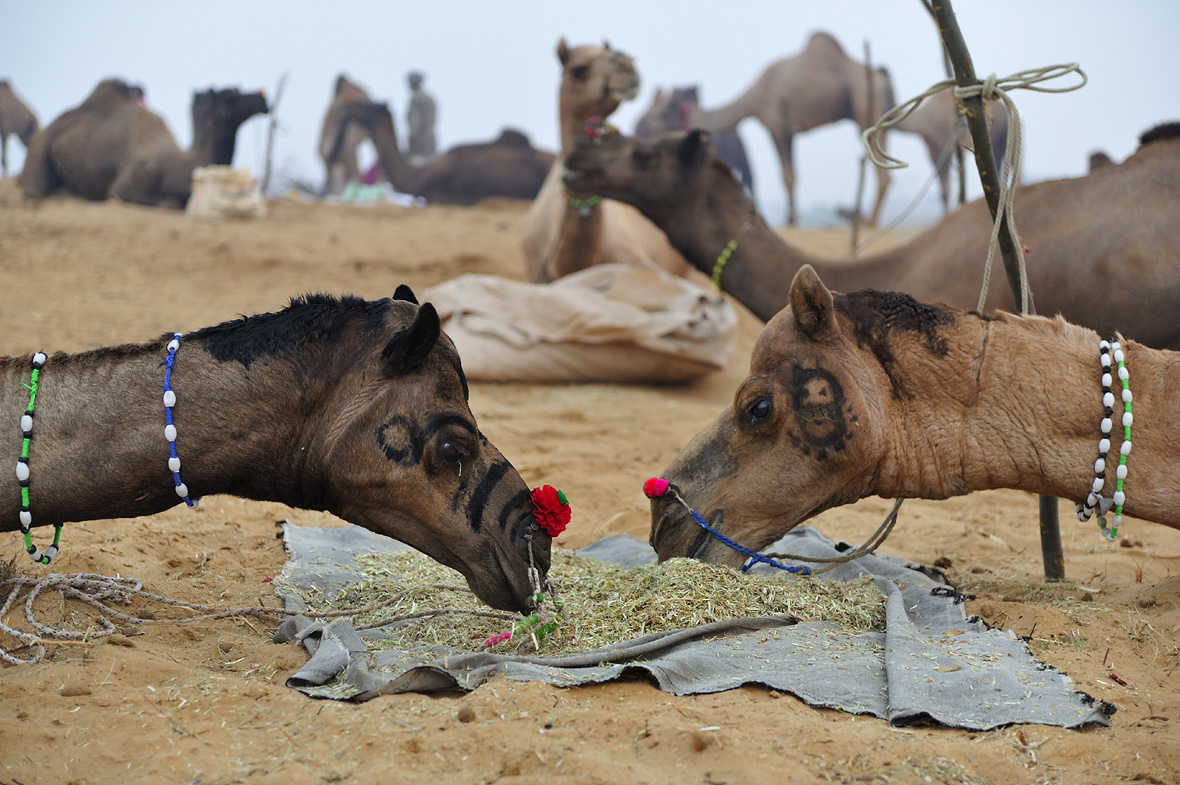
It is more comfortable to eat lying down
|
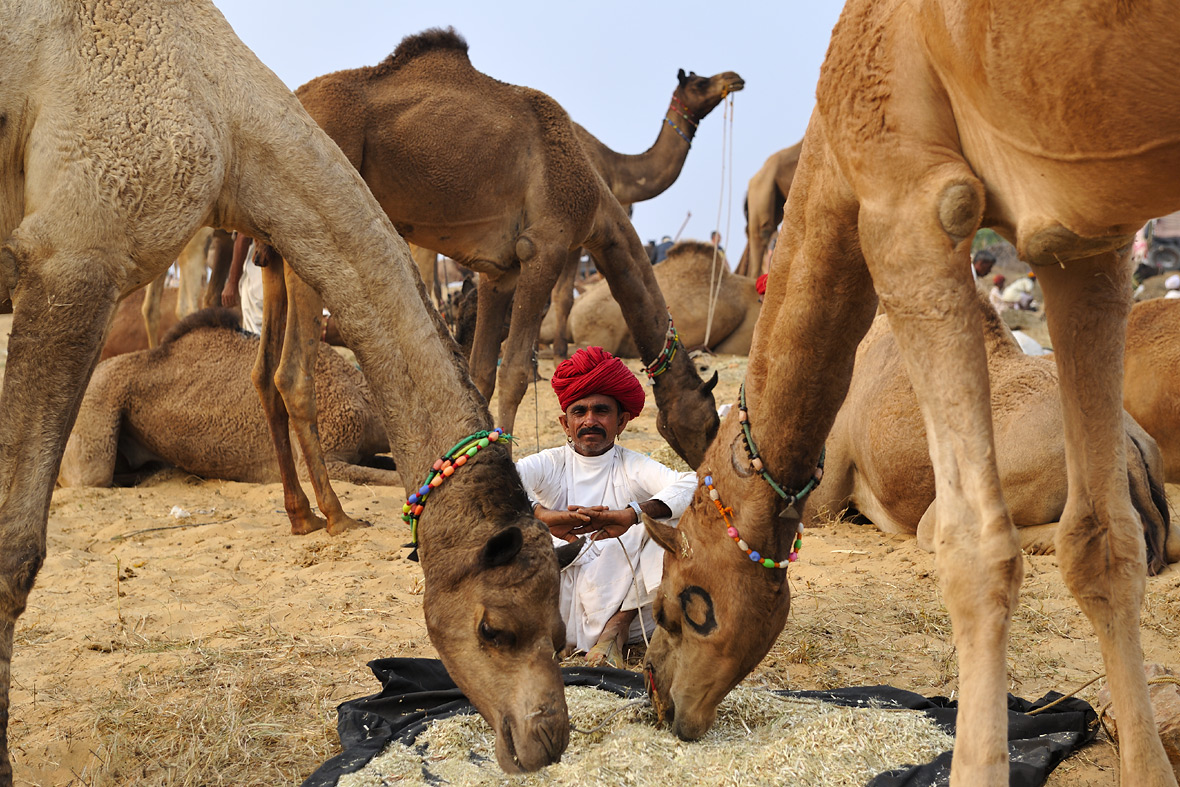 A long day
at the fair requires patience ...
A long day
at the fair requires patience ...
|
|
When
potential camel buyers finally arrive, and the dealers put on an act of
being uninterested, talk about this, that and the weather, including
all possible non-business related small talk, but between the lines the
real thing, the business dealing, the transaction is actually taking
place. If the buyer shows interest, then the camels are presented; in
case of a genuine interest, they are closely inspected. Most of the
camels are quite docile, some are however rather rebellious, which
makes the sellers visibly nervous!
|
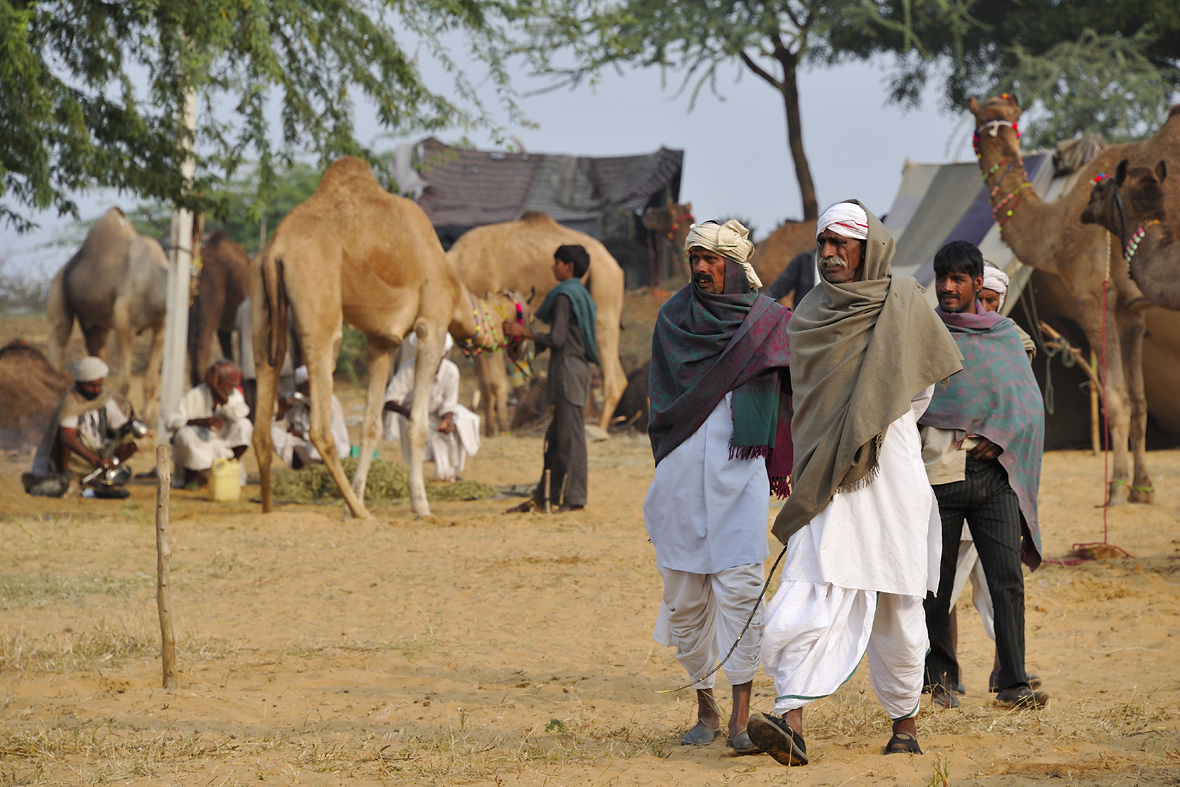 The camel
buyers come closer!
The camel
buyers come closer!
|
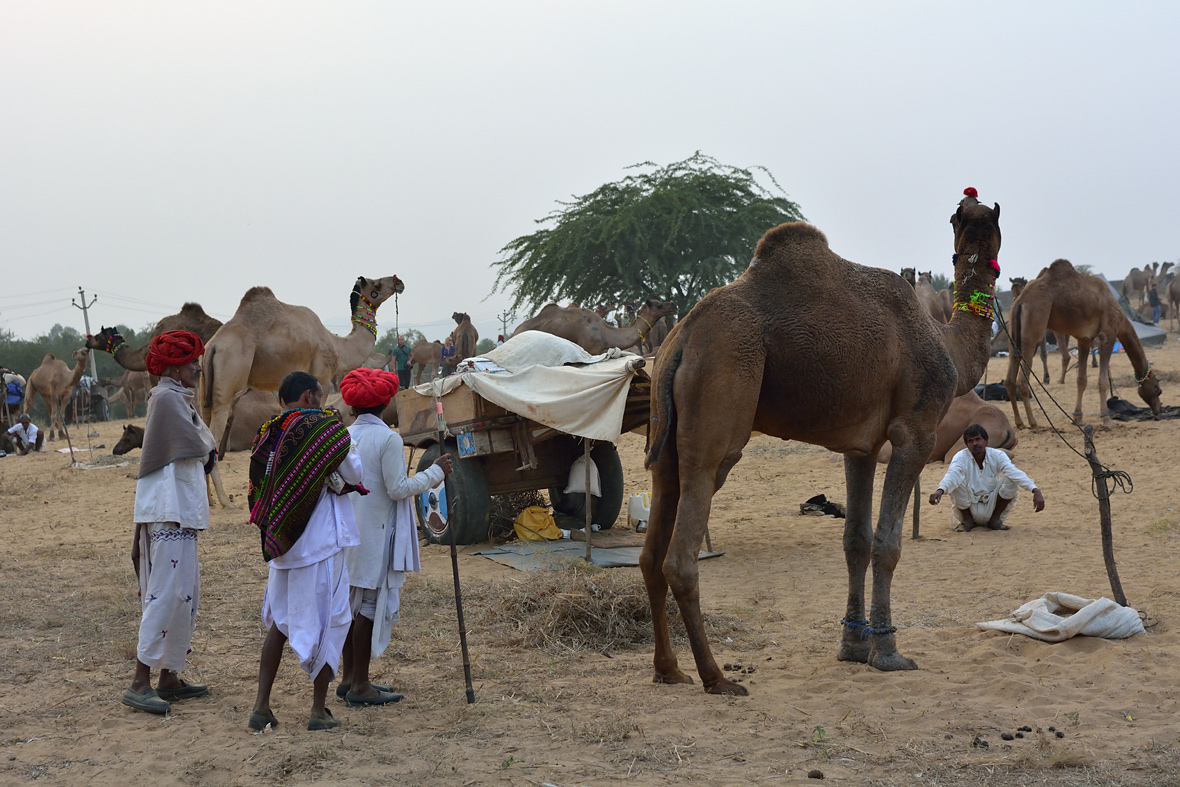
Camel-Shopping
|
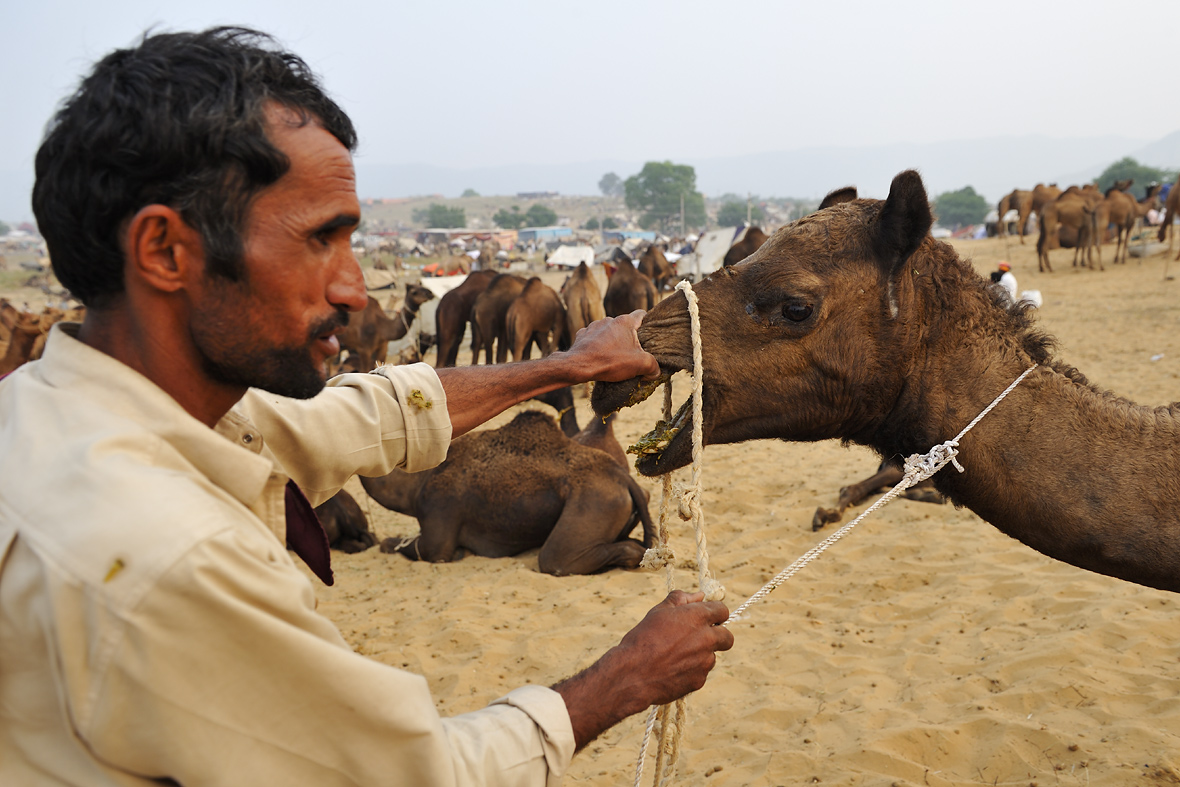
When they don't like
something, camels can become quite unrulyn
|
|
|
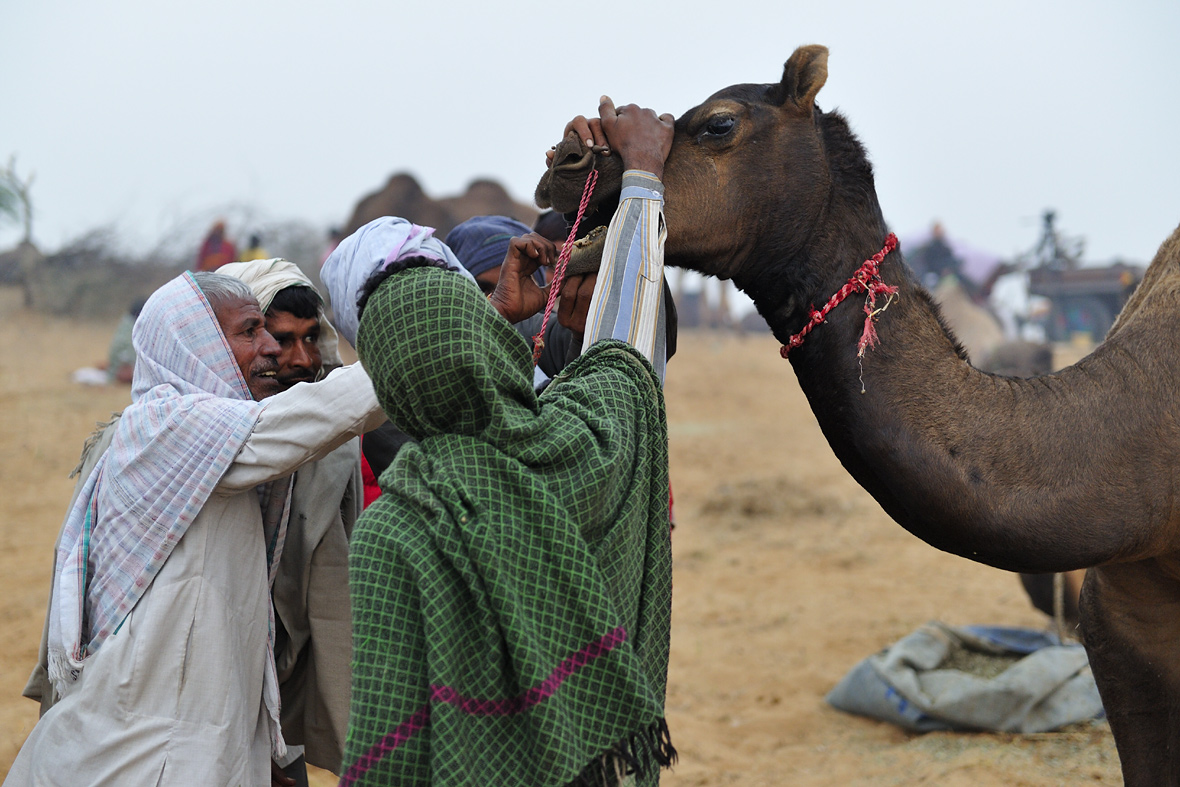
Buyers
inspect a camel
|
|
|
|
I absorb everything,
and take
photos with a delightful concentration, and with each passing hour,
feel more and more comfortable, as I become familiar with the camels,
whom I often end up pestering while taking photos, as I observe the
entire colourful setting with a growing curiosity.
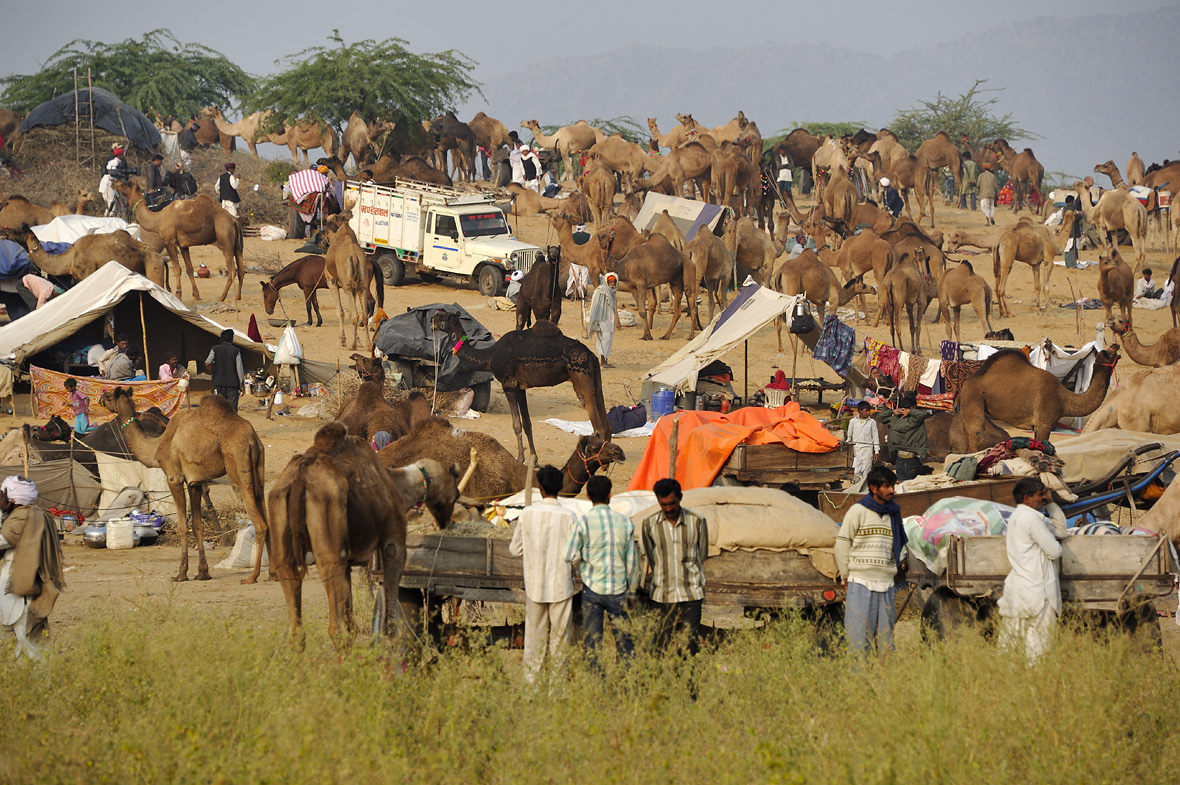
A small excerpt
from the 'Camel Camp’
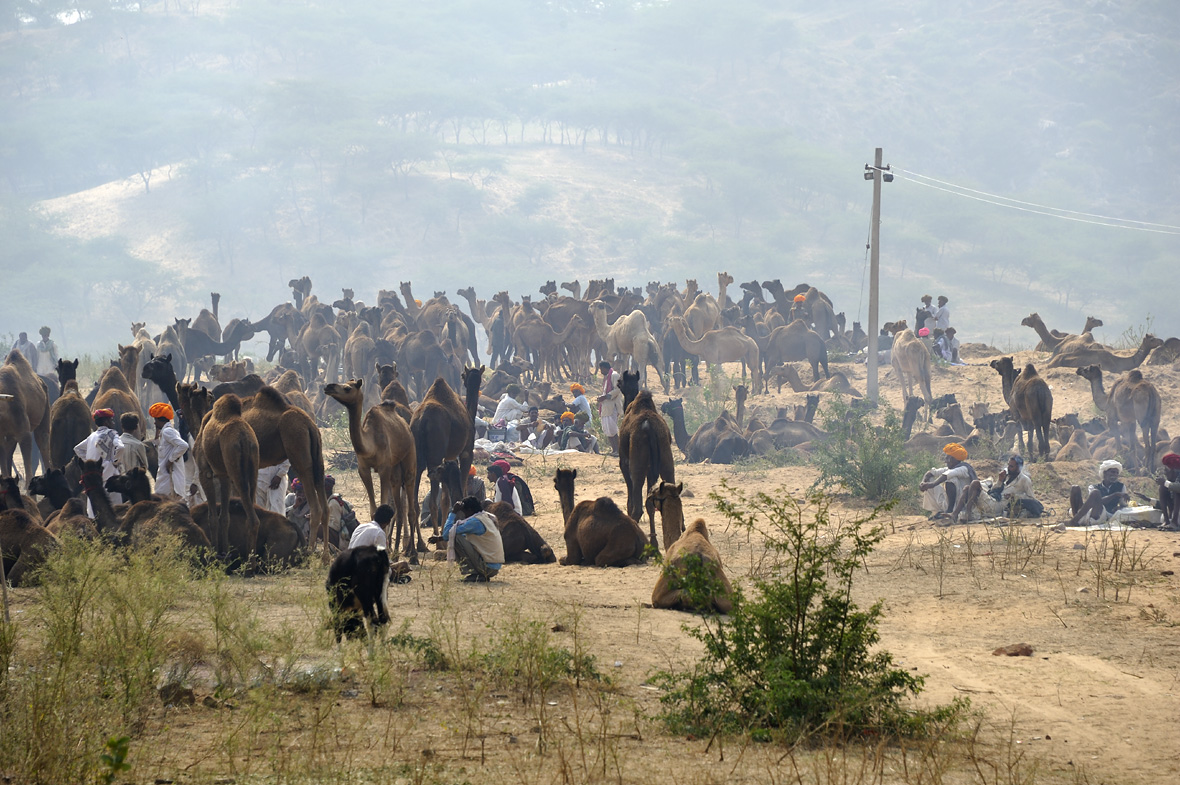
The camels increase in number as the day advances
|
With time,
the photos themselves become more intense, more up-close. At one point,
a camel scares me as it sniffs at me from the side with its huge head;
I wince, which equally scares the camel, who pulls back in turn and we
stare at each other for a moment, with big eyes and curious glances.
Our common reaction makes me very sympathetic towards the camel, mainly
because it did not want to bite me at all!
A scene at the watering trough astonishes me nevertheless, a young boy,
standing on the edge of a wall, waiting for his camel, gently strokes
it on the head, as the animal stands still, obviously enjoying it. I
would have never expected so much intimacy from these animals! I move
on further across the Camp Ground in the direction of the
city.
The closer I get, the more I get to see the full scope of the market.
In the course of time, a huge funfair
has developed around the Pushkar Mela and the Pushkar Pooja. |
|
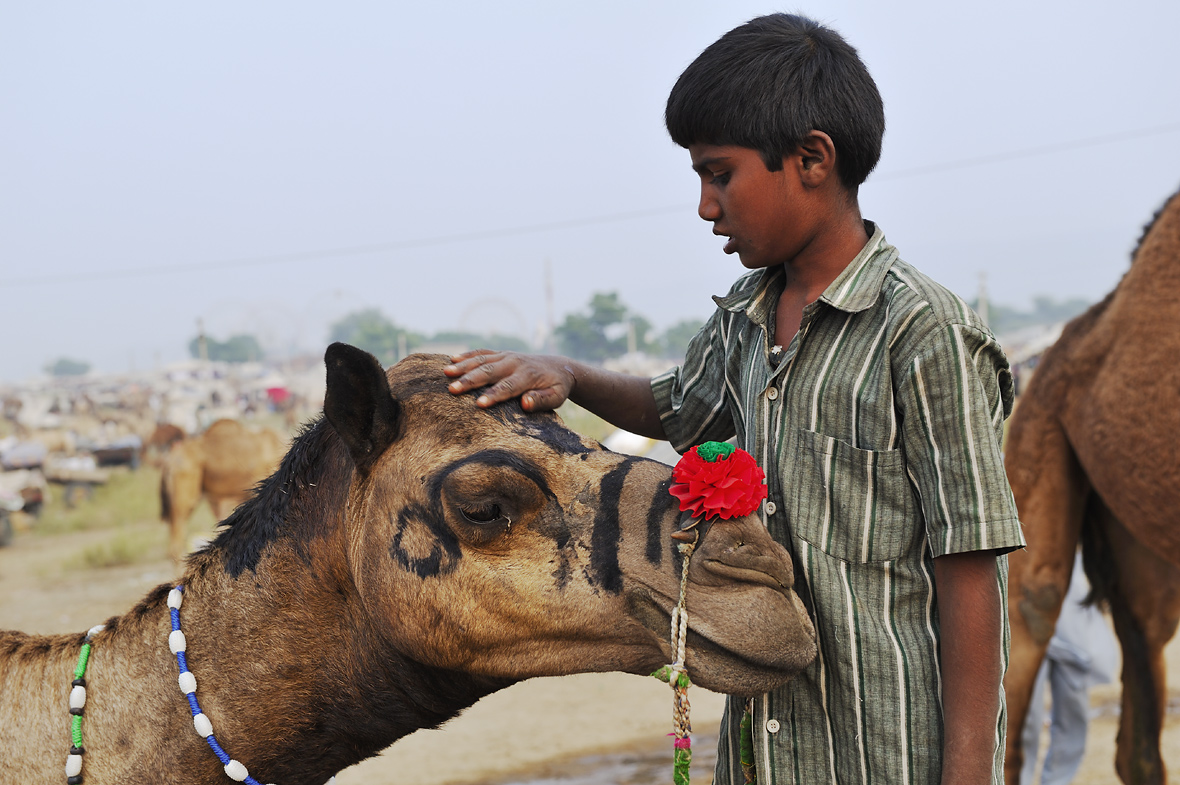
I would have never expected so much
intimacy from the camels!
|
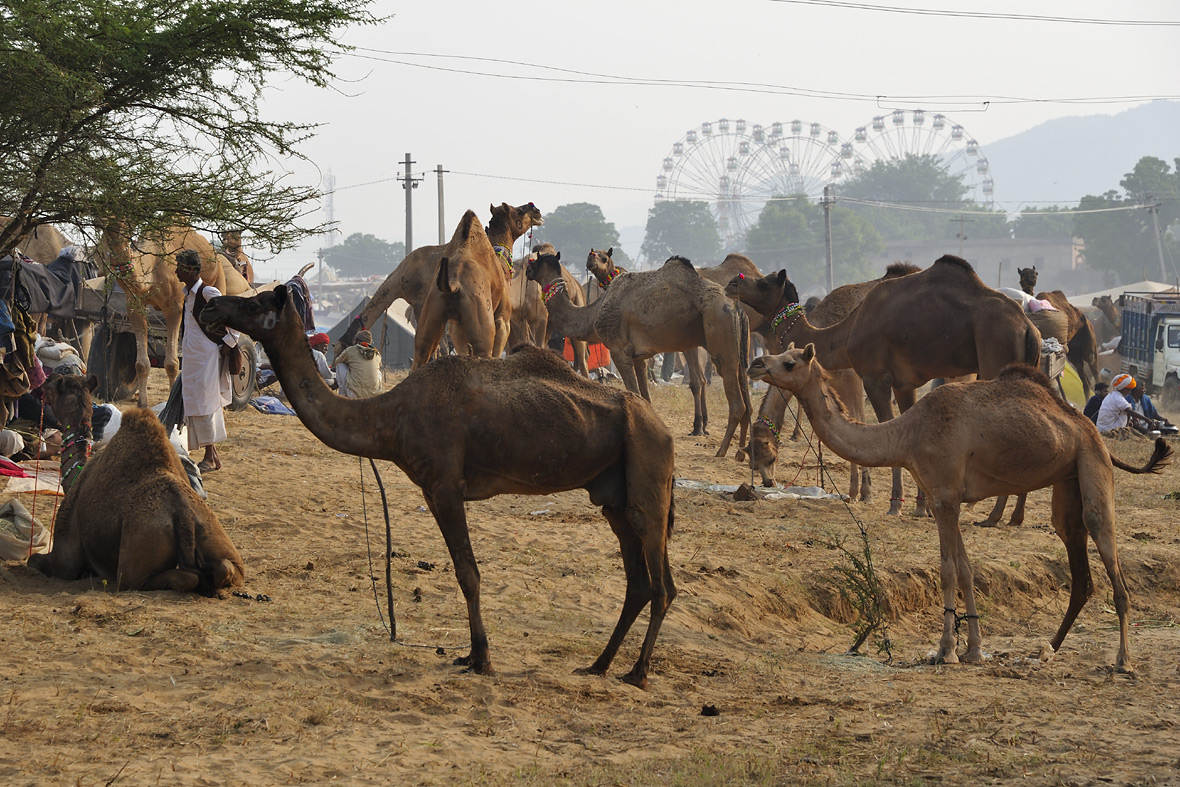
A huge
funfair has sprung up around the Pushkar Festival
|
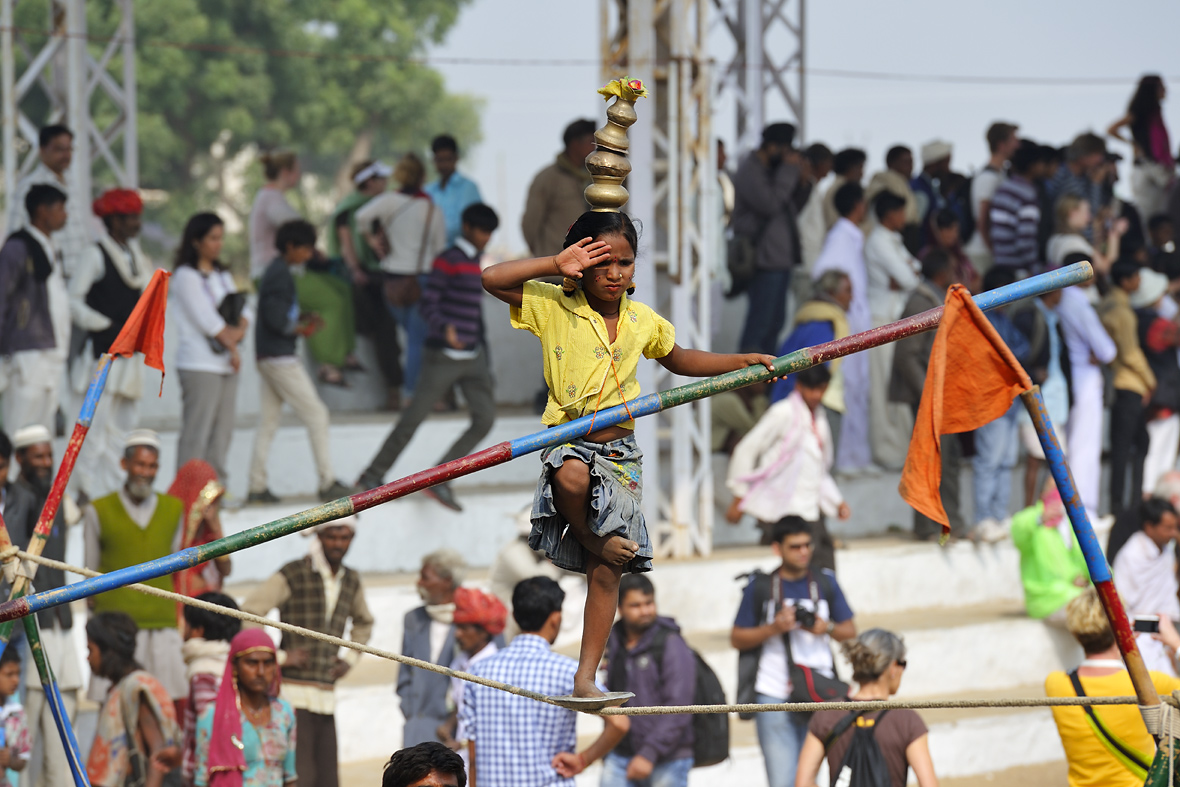
A tiny tightrope-walker in the Pushkar
Stadium
|
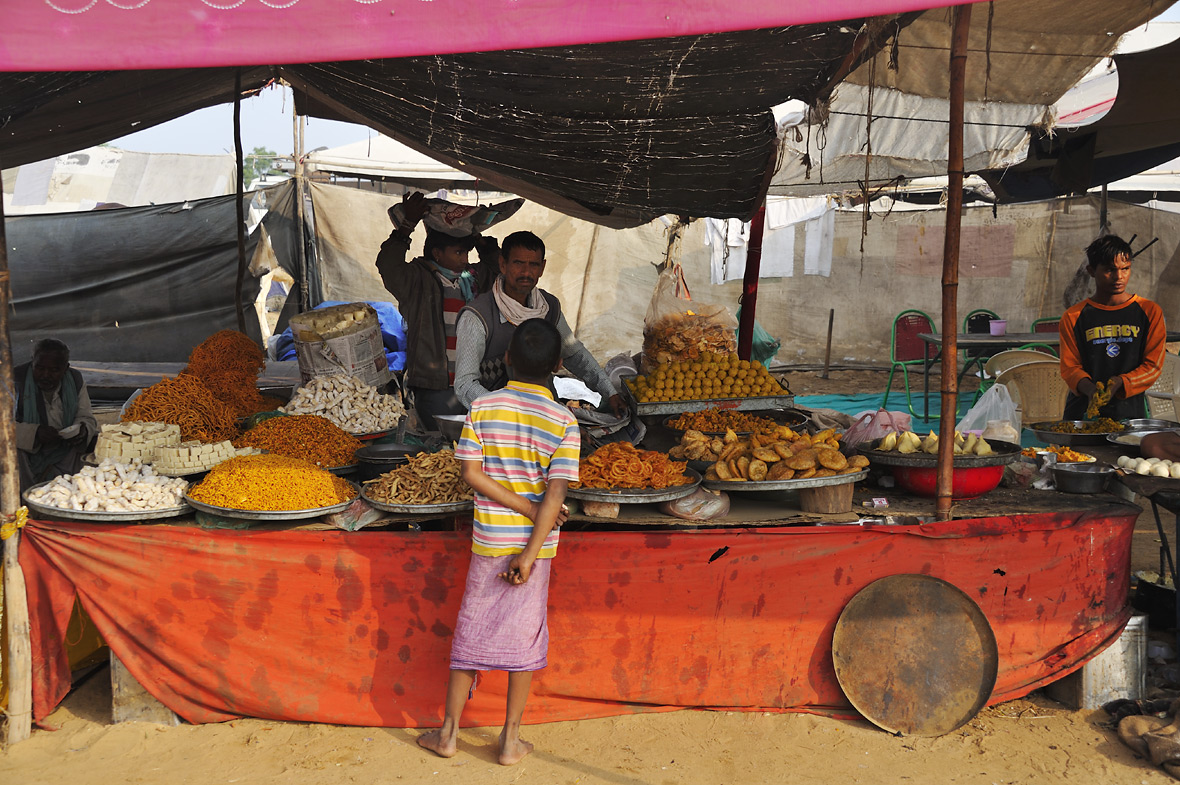
A portable
snack stall
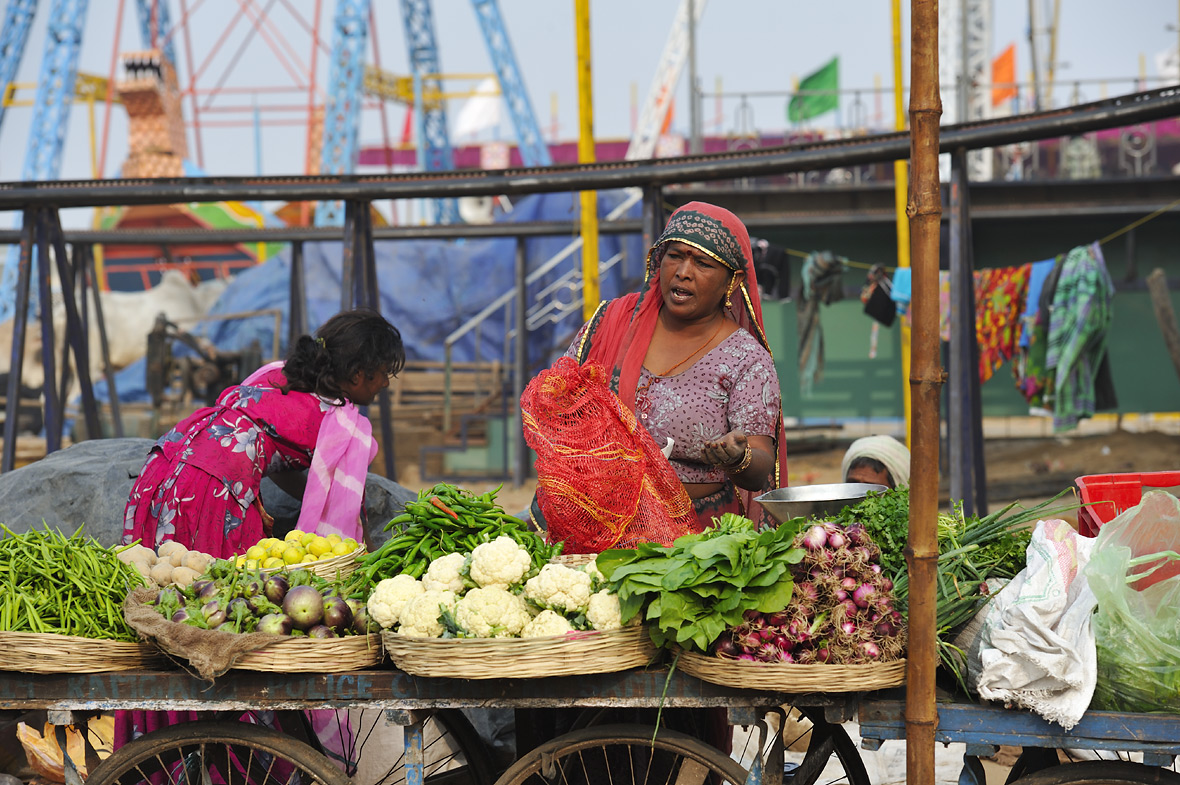
A
greengrocer at a hastily-set up cart
|
The
physical well-being and the necessary flow of goods of all the camel
breeders and traders, camel buyers, gawkers and tourists in the camp,
are looked after by tea and take-away stall owners, who have travelled
here specially for the camp, vegetable sellers on carts or in hastily
set up tents, grocers without stalls or tables, who simply pile their
fruits and vegetables on the ground, wandering peanut-, camel dung- and
camel feed sellers, camel jewelry vendors, cigarette and what-have-you
smugglers, as well as a flying shoe-maker in his beautifully decorated
tent.
And amongst all the entertainers such as tightrope walkers, traveling
sitar players, magicians, itinerant preachers, snake charmers, dancers
and circus performers mingle countless tourists and photographers; the
first sadhus, a type of monk, are already arriving for the holy
festival Pushkar Puja,
and so are pickpockets and quacks, beggars are anyway always present,
now they have simply become more in number; cows in search of something
edible trot along undeterred as always through the motley crowd, and
the pigs and goats running around do not attract attention at all.
For the entertainment of all, there are fixed installations such as
three Ferris wheels, which are still being busily bolted and worked
upon on the first day of the fair, swinging ships, the “New
Kamal
Circus” which is yet to be built, two fully loaded hot air
balloons, information stands of various government agencies, in
addition to which, Indian “Mantra music” from
rattling, tin
loud speakers trickles all over the entire facilities and the city;
camel cart taxis transport people who can afford a few extra rupees
from A to B; or simply around in a circle: the tourists. |
|
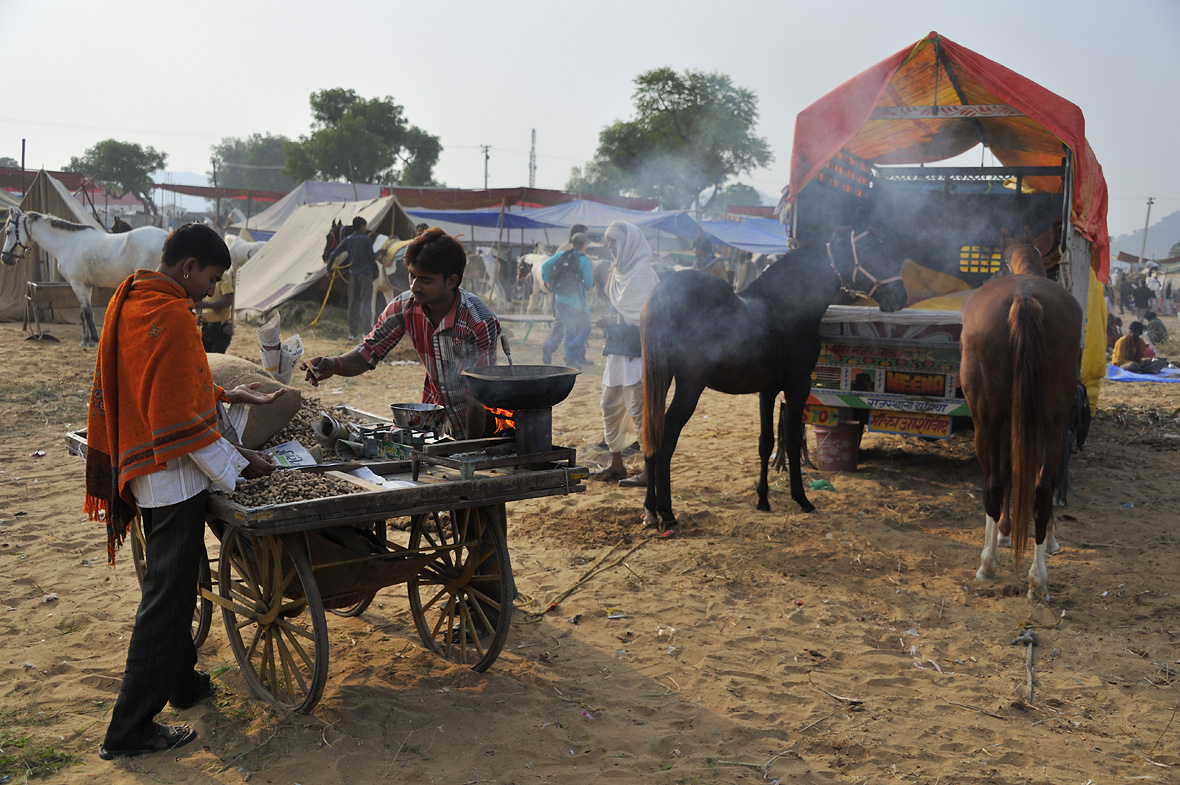
A wandering
peanut-seller at the horsemarket
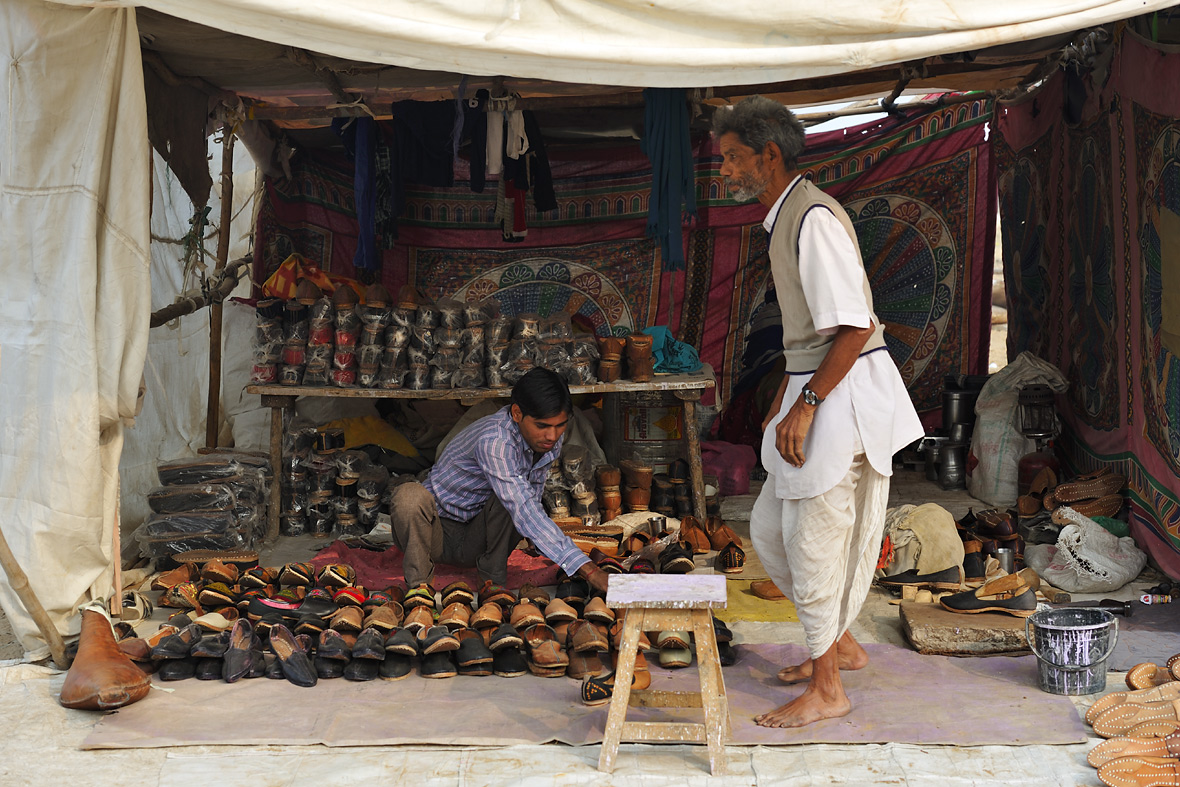
Flying shoemaker
|
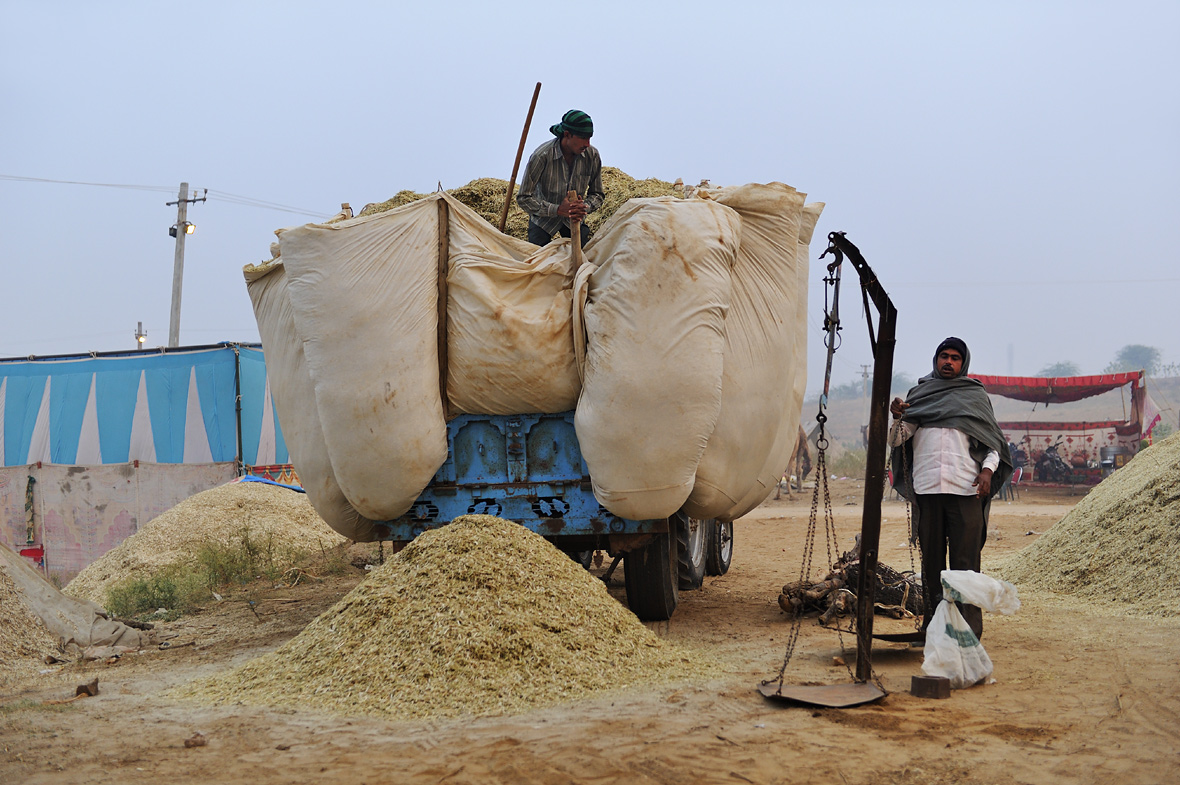
A local camelfeed-seller
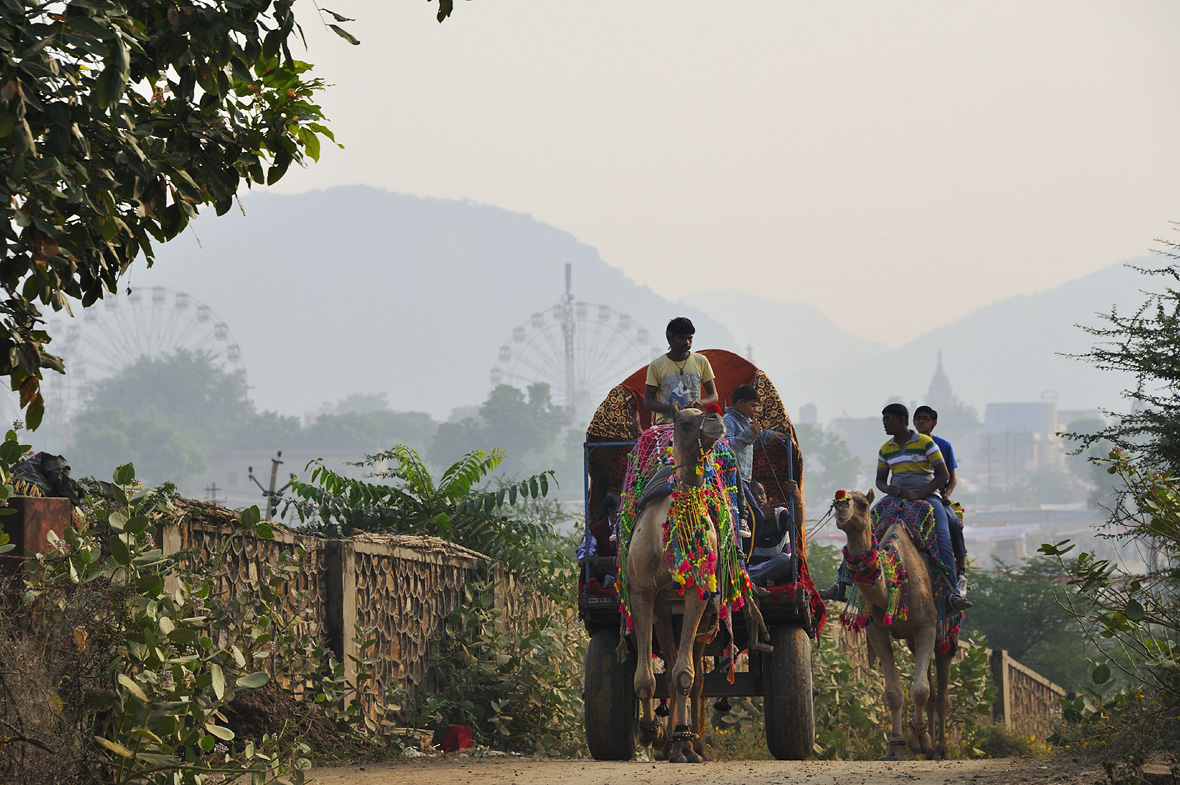
Camel-Taxis
|
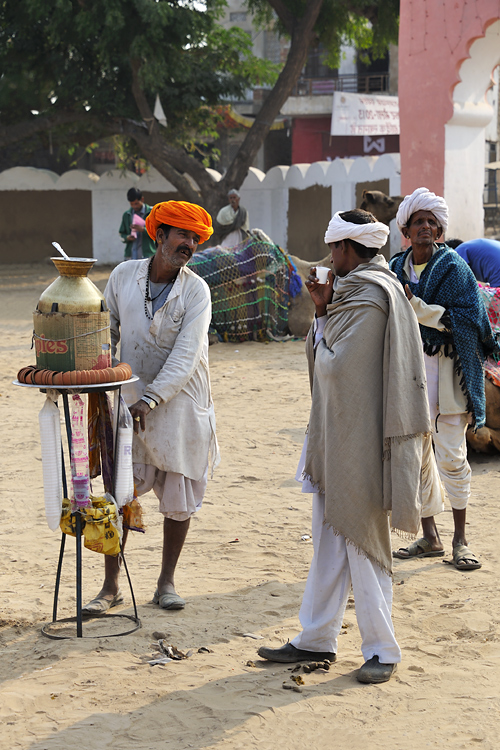
Traveling
Tea-sellers ('Chai Wallah')
|
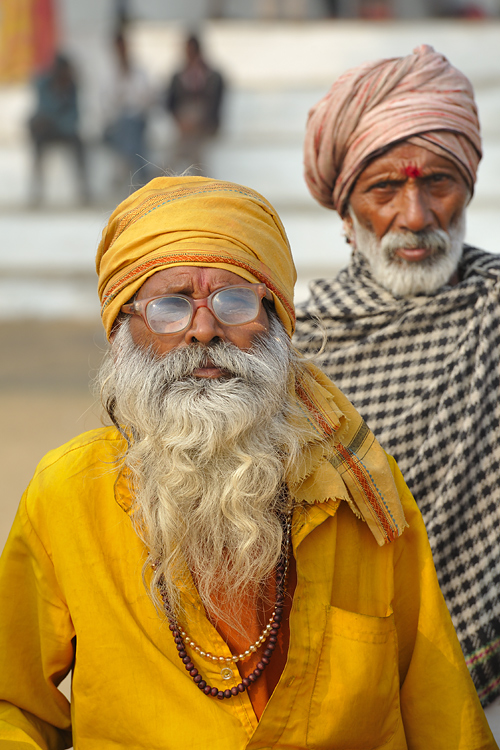
The first Sadhus are already
arriving
|
|
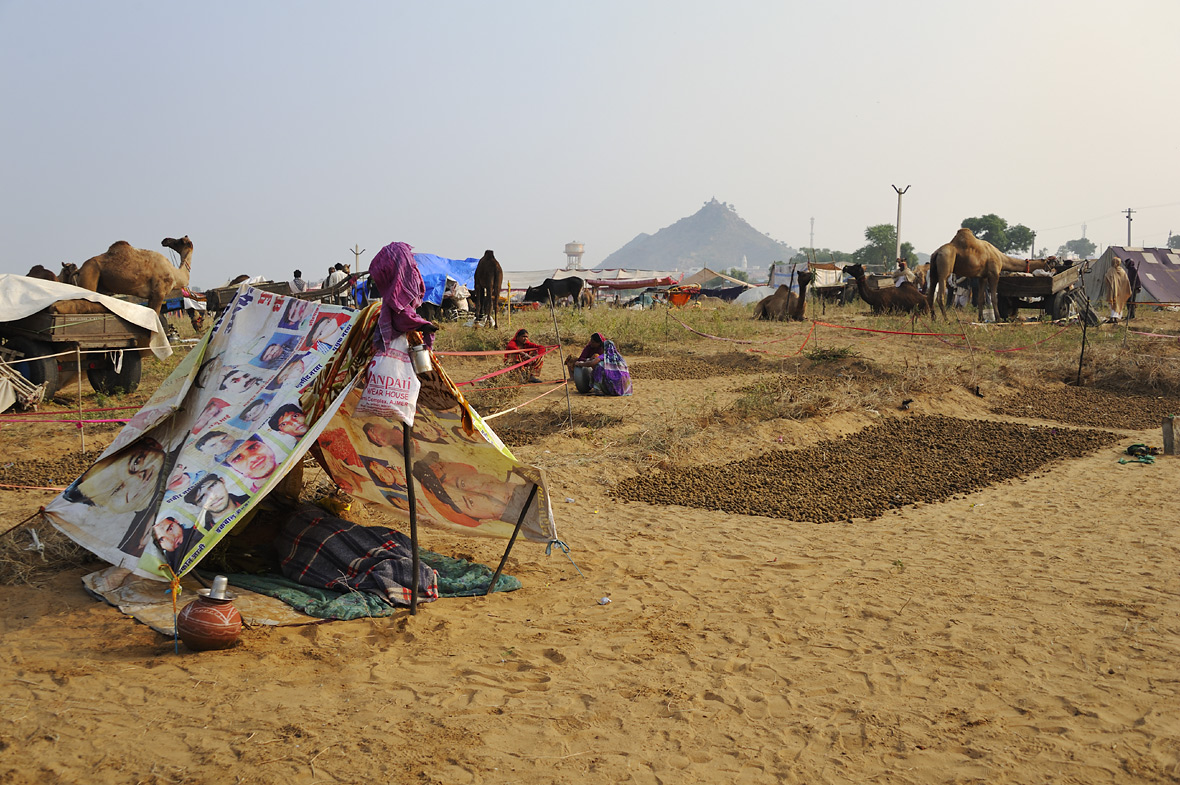
Sleeping
camel-dung trader
|
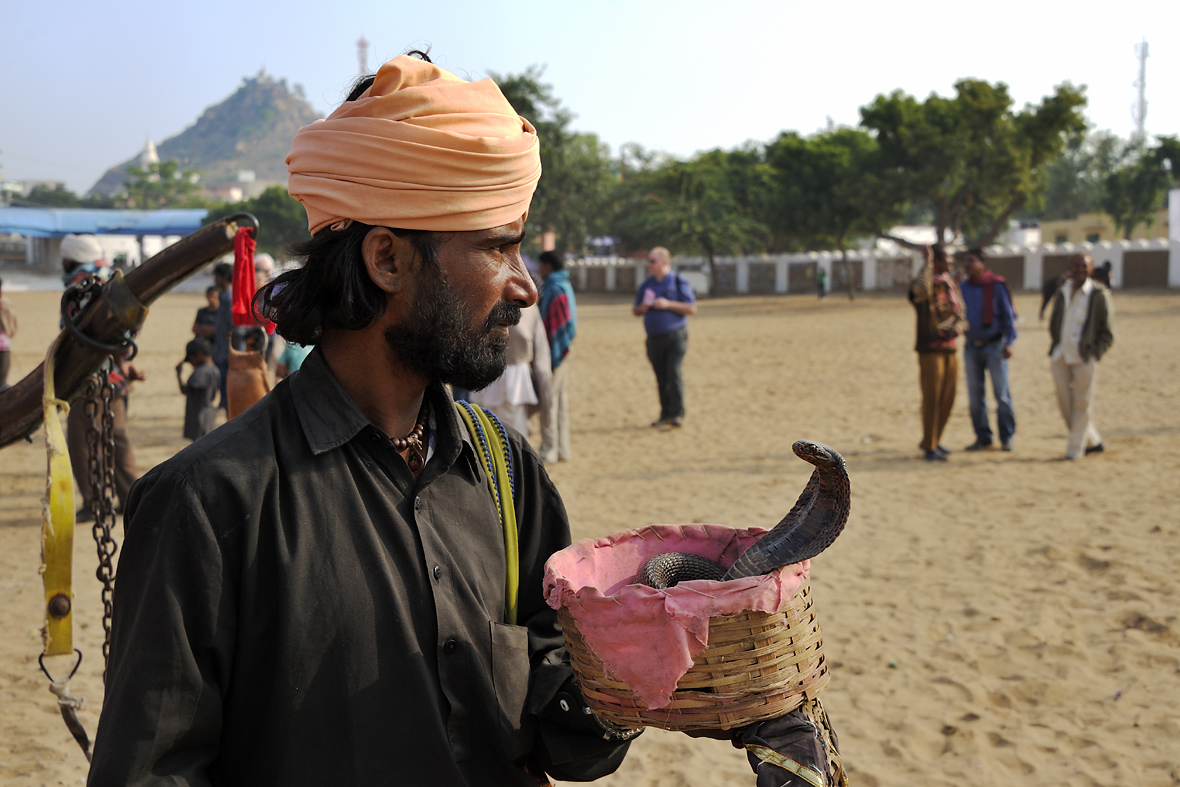
Snake-charmer
|
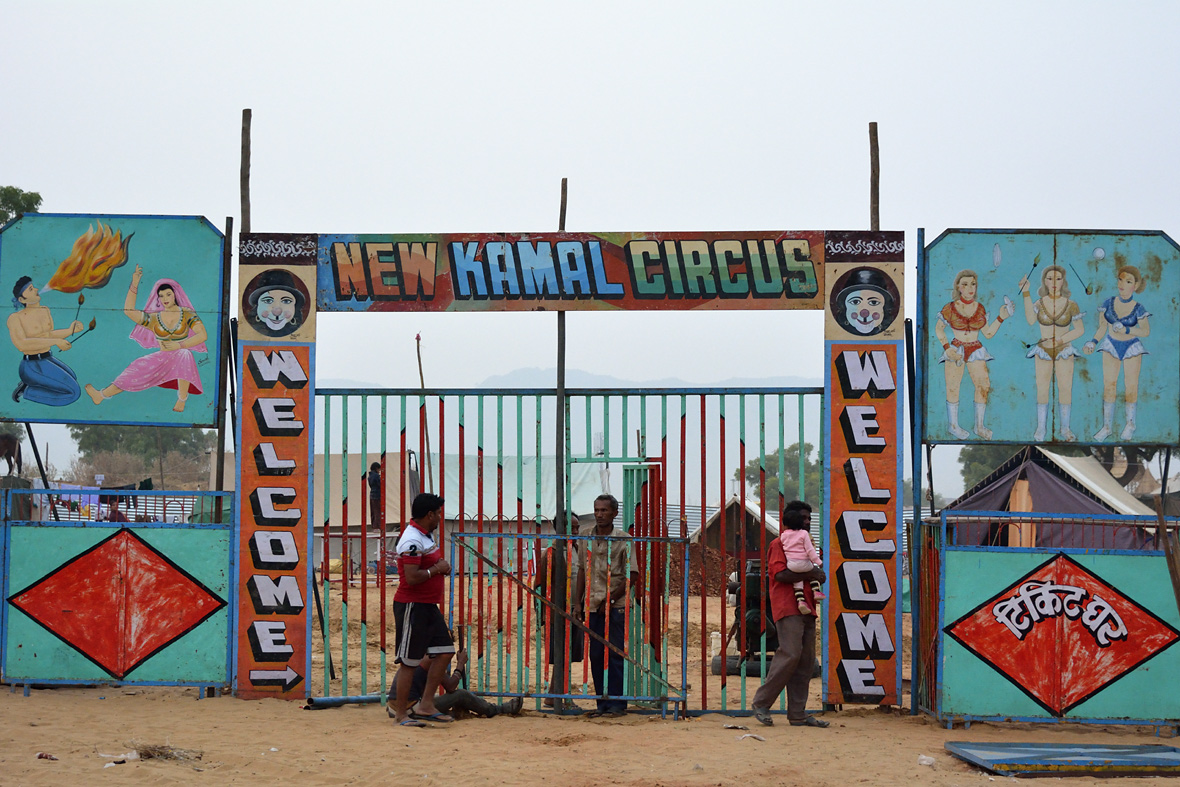
At the 'New
Kamal Circus', there is still work to be done
|
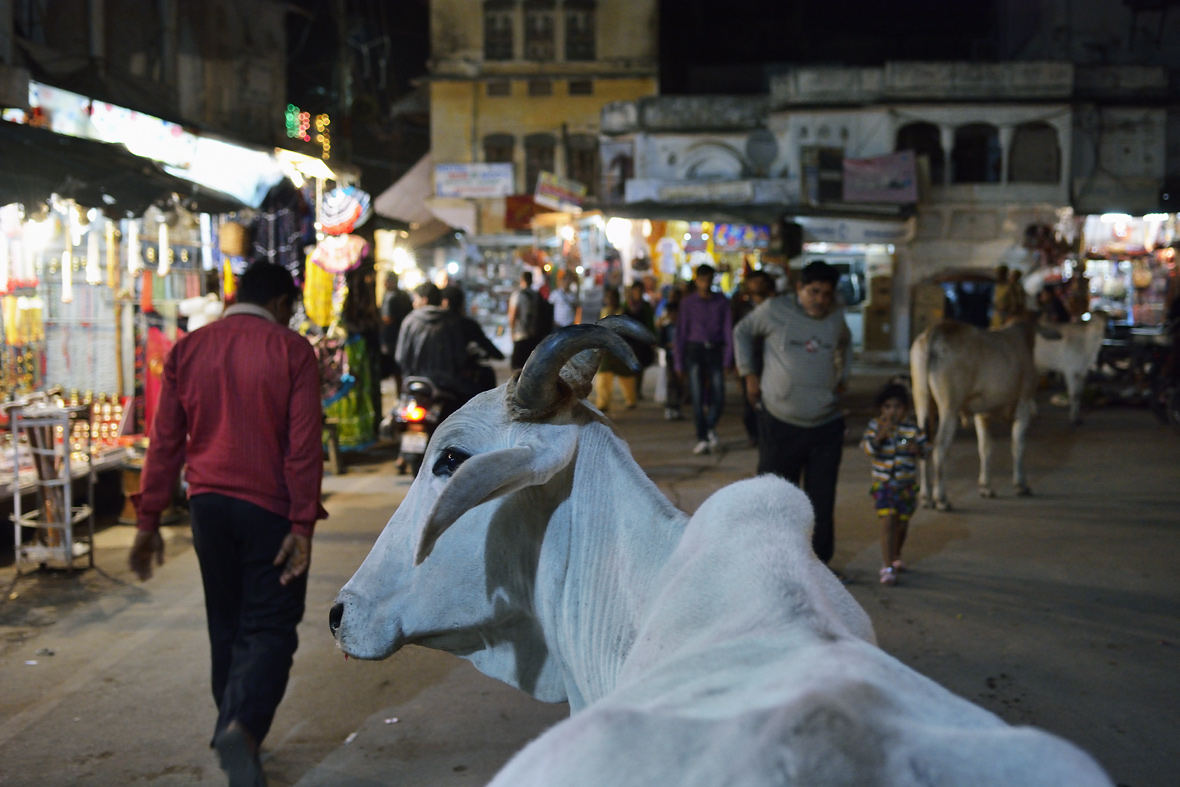
A cow in search of something
edible in Pushkar
|
|
|
|
